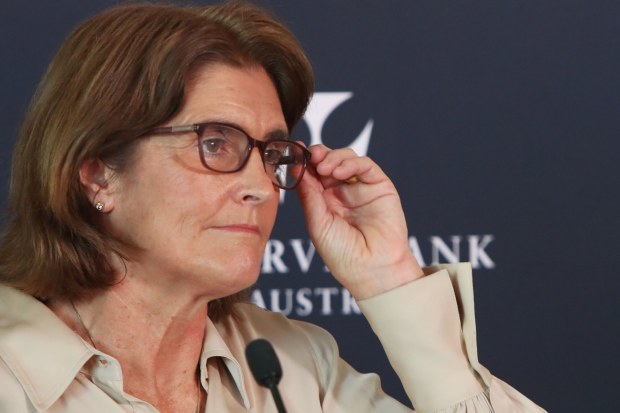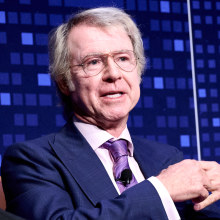RBA won’t cut interest rates until 2025

Australia is expected to be almost the last major advanced economy to deliver an interest rate cut, after hot US inflation caused professional investors to push out bets for a local monetary easing until early next year.
The deferral of an expected rate reduction until February is later than the Albanese government had hoped as a federal election approaches.

RBA Governor Michele Bullock could be a key figure in the next federal election. Bloomberg
It raises the possibility of the Reserve Bank of Australia’s interest rate policies and inflation becoming central issues at the federal election due by May next year.
Money market traders this week pushed back their expectations for the RBA’s first rate cut from November after stronger-than-expected US inflation figures raised fears that local prices could continue to rise rapidly.
It means the RBA’s first rate cut could come months after other central banks cut rates, according to market pricing from ANZ.
Former RBA official Jonathan Kearns said it would cut rates later than other central banks because it didn’t raise them as much.

Jonathan Kearns. Dominic Lorrimer
“Monetary policy was less tight in Australia than it was in other countries, and so therefore the disinflationary impetus coming from monetary policy has been less,” the Challenger chief economist said.
“Inflation is largely services-driven now.
“If you think about what wage growth is in Australia [4.2 per cent], and what productivity growth is, based off that inflation is not coming back down to 2.5 per cent unless we get a fairly significant slowing in wages growth or increasing productivity growth.”
The European Central Bank and the Bank of Canada are tipped to move first, with markets fully priced for them to start easing cycles in July.
They are expected to be followed by the US Federal Reserve and the Bank of England in September, and by the Reserve Bank of New Zealand in October.
A delay in rate cuts would make an early election unlikely – as the Albanese government hopes for multiple reductions before going to the polls.

Prime Minister Anthony Albanese may be forced to push back the next election. Alex Ellinghausen
But rate cuts by May next year are not a guarantee, with a handful of economists tipping a prolonged period of rates on hold, as well as the possibility of further increases.
AMP chief economist Shane Oliver said rate cut forecasts were more distant in Australia because inflation took off later than in other advanced economies.
The pass-through of the energy price shock caused by Russia’s invasion of Ukraine has also been more prolonged in Australia than overseas.
Australia isn’t the US
Markets pushed back expectations for rate cuts in Australia and America this week after US inflation accelerated to an annual rate of 3.5 per cent in March and core US inflation – which excludes the volatile food and energy categories – was a higher-than-expected 3.8 per cent.

Shane Oliver. Micahel Quelch
But Dr Oliver said local markets had over-reacted to US economic news, predicting a rate cut in August or September, despite fears high inflation could prove sticky.
“I think investors appear to be assuming Australian inflation will go the same way as in the US,” Dr Oliver said.
“A big factor behind the upside surprise and US inflation in January and February … was owner-occupier rents. In the US, rents have something close to a weight of 35 per cent in the CPI [consumer price index], whereas in Australia it’s about 6 per cent.
“Even though rents are rapidly rising here, they’re not going to have anywhere near the same effect they have in the US.”
Dr Oliver also said households in Australia were feeling the pain of high interest rates due to the dominance of variable-rate loans, whereas consumers in the US were still “alive and well”.
Early cut still possible
While Australian households had cut back on spending, Westpac chief economist Luci Ellis said per capita consumption in the US was increasing, in large part because of the Biden administration’s loose spending.
“In the United States, the federal government is running a budget deficit of around 6 per cent of GDP, with no consolidation in sight or even being seriously discussed,” Dr Ellis said.
“Income tax brackets are indexed to the CPI, so American households are not seeing that drag from higher tax payments.
“Together with the fact that average mortgage rates paid have risen far less in the United States, macro policy is barely touching the sides for the US consumer.”

Westpac chief economist Luci Ellis. Janie Barrett
Dr Ellis said the Albanese government’s more prudent budget policy was helping the RBA to take heat out of the economy and negated the need for further monetary tightening.
“While there is still a body of opinion holding that the RBA will not cut rates until 2025, a number of customers overseas ... are more likely to ask what would trigger the RBA to cut rates earlier than our current call for a late-September timing,” she said.
The National Australia Bank business survey released this week showed falls in labour costs, purchase costs, and buying and selling prices, which Dr Oliver said implied a further decline in inflation in Australia.
Subscribe to gift this article
Gift 5 articles to anyone you choose each month when you subscribe.
Subscribe nowAlready a subscriber?
Introducing your Newsfeed
Follow the topics, people and companies that matter to you.
Find out moreRead More
Latest In Economy
Fetching latest articles